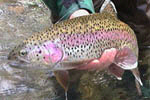|
A
few years ago, I
wanted to tie a nymph with somewhat universal appeal in the New
England streams and rivers that I frequent. What was born of this
desire was a pattern tied on a scud hook that can imitate many
things specifically, or suggest many things in general. It looked
fairly bland and simple, but I believe that is part of its appeal.
The flyís name came
to me after a culmination of trial and error on the water and with a
little help from an unexpected source. I had been vexed with trying
to come up with a name for the pattern, until my birthday in the
fall of 2000. My wife and I were on the Housatonic River in western
Connecticut, and my usual patterns hadnít been producing. Anne
suggested that I try the newer "unnamed fly", as she called it, so I
obliged. The next 30 minutes produced about 20 chubs, and nothing
else.
After that event,
the fly was relegated to the back of my fly box as a last resort,
and when it was next used it proved its worth on some picky brown
trout. When I told my wife of my success with the pattern on the
browns, she wasnít sure of which fly I was referring. When I showed
one to her, she said "Oh yeah, the Chub Bug." The name has stuck,
and since then it has taken rainbows, landlocked salmon, smallmouth
bass, crappie, most species of sunfish, and perch. I look forward to
trying some color combinations on brook trout here in the East and
cutthroat trout out West in the near future.
Depending upon the
colors of dubbing that are used, this pattern can imitate numerous
food sources, including scuds, aquatic worms, hellgrammites,
tadpoles, grubs and various larvae and pupae. When using contrasting
colors for the thorax and abdomen, a peeking caddis and other
emerging insects can be imitated. Iíve had better success using
copper bead heads with the dark flies and gold bead heads with
medium to light flies. This fly usually drifts upside down (i.e.,
hook point up), but such a drift can be guaranteed by tying a thin
strip of lead on top of the hook shank prior to tying in the
tail.
This pattern is
most effectively fished using a dead drift right above the bottom.
Itís a good searching fly when covering a lot of water, and when
tied in bright yellow or pink itís a proven attractor
pattern.
--Mark Dysinger
|



